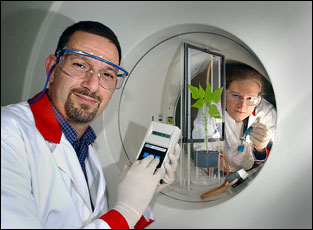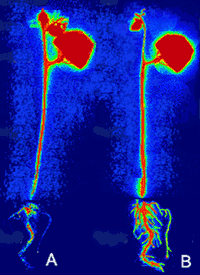Poplar Trees Redirect Resources in Response to Simulated Attack
Use of "functional imaging" to track plant nutrients has many potential applications
March 28, 2005
UPTON, NY - Scientists at the U.S. Department of Energy's Brookhaven National Laboratory have applied some of the same techniques used in medical imaging to track the distribution of nutrients in poplar trees in response to a simulated insect attack. The research provides new insights on a long-debated theory about how plants respond to environmental stress, and shows that radiotracer imaging can be a big help in unraveling plant biochemistry.
 enlarge
enlarge
Richard Ferrieri (L) and co-author Dennis Gray, now with the University of Connecticut, position a plant leaf in one of BNL's positron emission tomography (PET) scanners. Their research using radiotracers like those used in human PET scanning is helping to unravel the mysteries of plant biochemistry. (Click image to download hi-res version.)
Done in collaboration with scientists from Tufts University and Stony Brook University, the research is reported in two articles, to be published in Plant, Cell & Environment (June 2005) and in New Phytologist (August 2005), both now available online.
"Just as we've learned to use radiotracers to image the inner workings of the living human brain, we can now track biochemical and physiological processes within plants using these powerful imaging tools," said Richard Ferrieri, who leads Brookhaven's role in the research. "This enables us to study the effects of external factors like insect attacks, disease, elevated carbon dioxide, soil toxins, and drought on vital plant processes."
Ferrieri says scientists trying to improve plants' resistance to environmental challenges - or their ability to perform useful tasks such as carbon sequestration, phytoremediation, or the production of bio-fuels - could also use functional imaging to help track their progress.
In the New Phytologist study, the scientists asked how plants deal with an external stress, such as an insect attack. "We know that plants respond defensively to attacks, for example, by producing chemicals that kill off the attackers or make their own leaves less tasty," said Benjamin Babst, a Ph.D. student in the biology department at Tufts University and lead author on that paper. "But there's a suspicion that plants also respond by building up tolerance, for example by putting aside more carbon into storage so it will be available to help the plant spring back to life once the attack has passed. Using the techniques developed at Brookhaven, we now have a way to find out."
 enlarge
enlarge
Scientists produced these positron radiographs by administering discrete pulses of carbon-11-labeled carbon dioxide gas to a single intact leaf of a poplar sapling and taking a snapshot of the distribution of carbohydrates that incorporated the C-11 radiotracer via the process of photosynthesis one hour later. Panel A shows the distribution of carbohydrate in the untreated plant (red is high; blue is low). Panel B shows that when that same plant is retested after exposure to jasmonic acid, a potent plant hormone that makes the plant 'think' it's under attack, it partitions more of its carbohydrates to the roots for storage. (Click image to download hi-res version.)
To simulate an insect attack, the scientists painted a solution of jasmonic acid, a chemical messenger that plants produce in response to various types of stress, onto the leaves of poplar trees in a closed chamber. They then administered carbon dioxide gas "labeled" with radioactive carbon-11 to individual leaves, where it is quickly converted to sugar, and traced the movement of this radiolabeled sugar through the plants using autoradiography and other techniques. Autoradiography allows for taking a snapshot in time showing the precise location of the radiotracer within the plant. With this and other techniques, the scientists can compare what that plant does with the carbon dioxide both before and after an attack.
"Carbon dioxide is a plant's major resource. To see how it is allocated into various biochemical pathways is an incredibly powerful tool for learning how plants cope with stress," says plant scientist Michael Thorpe who is helping to build the plant-imaging program at Brookhaven.
Plants subjected to the jasmonic acid "attack" produced more radiolabeled sugar and delivered more of it to the roots than plants untreated with the hormone. "This is pretty convincing evidence that plants can respond 'passively' by redirecting their nutrients away from the site of attack and placing them into storage for later regrowth," Ferrieri said.
Supporting evidence comes from the amount of carbon-11 the scientists detected in isoprene, a hydrocarbon gas that is a byproduct of sugar synthesis in the leaves. That research, reported in Plant, Cell & Environment, shows that, in response to jasmonic acid "attack," the plants diverted more newly acquired carbon into isoprene production. "Scientists are only just beginning to realize that isoprene has a vital role as an antioxidant in helping plants tolerate many different stresses, for example from insects or ozone," Ferrieri said.
The scientists have not yet determined if more sugar gets stored in the plants' roots, a key component of the theory. "Because the radiotracer has such a short half-life (20.4 minutes), we can see that more is going to the roots, but not the chemical form it takes there," Ferrieri said. "We will have to do more tests to see what compounds are formed."
Ferrieri believes there may be an increase in compounds that resist microbial attack after plants have soaked up atmospheric carbon dioxide, therefore countering the effects of fossil-fuel combustion. This is a strategy of carbon sequestration - the provision of long-term storage of carbon so that the buildup of carbon dioxide in the atmosphere will be reduced.
The research was funded by Brookhaven's Laboratory Directed Research and Development (LDRD) program with support from the Office of Biological and Environmental Research within the U.S. Department of Energy's Office of Science.
Note to local editors: Richard Ferrieri lives in Patchogue, New York; Michael Thorpe lives in Bellport, New York.
2005-10293 | INT/EXT | Newsroom









